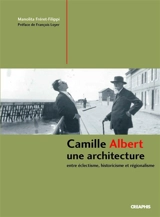
L'architecture de la Grèce au XIXe siècle (1821-1912)
François Loyer
Versailles, Lyon 2ᵉ, Lyon 6ᵉ...
Ce que dit l'éditeurQuand la Grèce rejoignit l'Europe après plus de trois siècles de domination ottomane, il lui fallut se construire une culture moderne en rapport avec l'héritage plusieurs fois millénaire dont elle restait la dépositaire. Le néohellénisme a trouvé dans l'architecture un mode d'expression privilégié, où se croisaient les attentes d'une élite internationale en mal de références classiques et la tradition toujours vivante du monde byzantin, ciment de l'identité nationale. De l'ajustement de ces ambitions dans un contexte économique et politique difficile est née une production originale, tirant de sa confrontation avec l'Occident une forme d'authenticité d'autant plus significative qu elle était soumise à la pression constante des pays dominants. Entre identité et modernité, c'est un double projet qu'elle a poursuivi tout au cours du XIXe siècle pour se situer au sein d'un univers en pleine mutation. When Greece rejoined Europe after more than three centuries of Ottoman rule, the country needed to forge a modern culture that also connected with the thousands of years of patrimony of which it was the custodian. Neo-Hellenism found in architecture a privileged mode of expression, one which brought the expectations of an international elite lacking in classical references into contact with the still living tradition of the Byzantine world, the cement of national identity. The readjustment of these ambitions in a difficult economic and political context gave birth to a highly original output, which drew out of its confrontation with the West a form of authenticity that was all the more meaningful for having been subjected to the constant pressures of dominating countries. Between identity and modernity, this dual project was pursued throughout the nineteenth century and enabled Greece to situate itself at the heart of a world in a state of constant flux. |
RésuméUne étude sur l'architecture grecque du XIXe siècle, à une époque où le pays sort de plus de trois siècles de domination ottomane et cherche à se construire une culture moderne en rapport avec l'héritage multimillénaire dont il est le dépositaire. Le néo-hellénisme trouve ainsi dans l'architecture un mode d'expression privilégié, entre identité et modernité. ©Electre 2024 |
Caractéristiques Auteur(s) Éditeur(s) Date de parution
7 juin 2017
Collection(s)
Mondes méditerranéens et balkaniques
Rayon
Divers
Contributeur(s) Alexandre Farnoux
(Préfacier) EAN
9782869582767
Nombre de pages
361
pages
Reliure
Broché
Dimensions
24.0
cm x
19.0
cm x
2.0
cm
Poids
970
g
|











